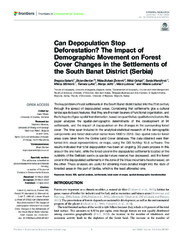Приказ основних података о документу
Can Depopulation Stop Deforestation? The Impact of Demographic Movement on Forest Cover Changes in the Settlements of the South Banat District (Serbia)
| dc.creator | Gatarić, Dragica | |
| dc.creator | Đerčan, Bojan | |
| dc.creator | Bubalo-Zivkovic, Milka | |
| dc.creator | Ostojić, Miloš | |
| dc.creator | Manojlović, Sanja | |
| dc.creator | Sibinović, Mikica | |
| dc.creator | Lukić, Tamara | |
| dc.creator | Jeftić, Marija R. | |
| dc.creator | Lutovac, Miloš | |
| dc.creator | Lutovac, Milena | |
| dc.date.accessioned | 2023-03-09T10:35:07Z | |
| dc.date.available | 2023-03-09T10:35:07Z | |
| dc.date.issued | 2022 | |
| dc.identifier.issn | 2296-665X | |
| dc.identifier.uri | http://gery.gef.bg.ac.rs/handle/123456789/1201 | |
| dc.description.abstract | The key problem of rural settlements in the South Banat district lasted into the 21st century through the spread of depopulated areas. Considering that settlements give a cultural landscape its basic features, that they are the main bearers of functional organization, and the hotspots of geo-spatial transformation, based on quantitative-qualitative indicators this paper analyzes the spatial-demographic determinants of the development of 94 settlements, and the impact of depopulation on the changes in the surrounding forest cover. The time span included in the analytical-statistical research of the demographic components and forest dislocation lasted from 1990 to 2018. Geo-spatial data for forest areas were taken from the Corine Land Cover database. The data obtained were then turned into visual representations, or maps, using the GIS ArcMap 10.8. software. The results indicated that total depopulation has been an ongoing, 30-years process in this area on the one hand, while the forest cover in the depopulated settlements located on the outskirts of the Deliblato sands (a special nature reserve) has decreased, and the forest cover in the depopulated settlements in the zone of the Vršac mountains has increased, on the other. These analyses are useful for obtaining more detailed insight into the state of forested areas in this part of Serbia, which is the least afforested one. | sr |
| dc.language.iso | en | sr |
| dc.publisher | Frontiers Media SA | sr |
| dc.relation | info:eu-repo/grantAgreement/MESTD/inst-2020/200091/RS// | sr |
| dc.relation | info:eu-repo/grantAgreement/MESTD/inst-2020/200125/RS// | sr |
| dc.relation | Provincial Secretariat for Higher Education and Scientific Research (Grant No. 142-451-2615/2021-01/1) | sr |
| dc.rights | openAccess | sr |
| dc.rights.uri | https://creativecommons.org/licenses/by/4.0/ | |
| dc.source | Frontiers in Environmental Science | sr |
| dc.subject | forest | sr |
| dc.subject | GIS | sr |
| dc.subject | spatial analysis | sr |
| dc.subject | settlements | sr |
| dc.subject | land cover changes | sr |
| dc.subject | spatial-demographic transformation | sr |
| dc.title | Can Depopulation Stop Deforestation? The Impact of Demographic Movement on Forest Cover Changes in the Settlements of the South Banat District (Serbia) | sr |
| dc.type | article | sr |
| dc.rights.license | BY | sr |
| dcterms.abstract | Јефтић, Марија Р.; Сибиновић, Микица; Лутовац, Милош; Лутовац, Милена; Манојловић, Сања; Лукић, Тамара; Бубало-Зивковиц, Милка; Ђерчан, Бојан; Гатарић, Драгица; Остојић, Милош; | |
| dc.citation.volume | 10 | |
| dc.citation.spage | 897201 | |
| dc.citation.rank | M21 | |
| dc.identifier.wos | 000796191200001 | |
| dc.identifier.doi | 10.3389/fenvs.2022.897201 | |
| dc.identifier.scopus | 2-s2.0-85129700808 | |
| dc.identifier.fulltext | http://gery.gef.bg.ac.rs/bitstream/id/2780/fenvs-10-897201.pdf | |
| dc.type.version | publishedVersion | sr |


